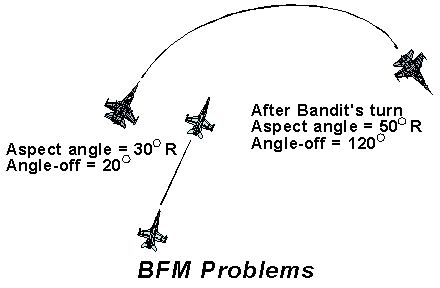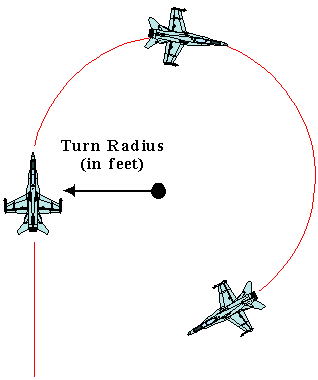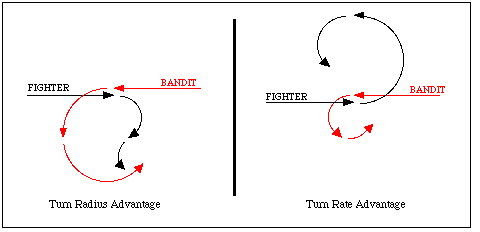- Specific Excess Power (Ps) - A measure of an airplane's ability to gain or lose energy in terms of altitude, airspeed, or combination there of also called energy rate and expressed in feet per second or knots per second. Remember that you trade energy for position.
- Turn Radius - Turn Radius is one of the two elements of a turn. Turn radius is
the measure of how tight your jet turns. This is the distance from the center of your turn
circle to the aircraft measured in feet. The formula for this is:

V = aircraft's velocity in feet per second
g = gravity
G = the G the aircraft is pulling.
Notice that velocity is squared meaning that turn radius will grow exponentially based on velocity. And the more G's you pull, the tighter the turn. But as you can see, smash (airspeed) has a greater effect on turn radius than G.
- Turn Rate - This indicates how fast the aircraft moves around its turn radius. It
is measured in degrees per second and is also dependent on G's and airspeed. The equation
for turn rate is:

K = constant
G = the G's the aircraft is pulling
V = aircraft velocity (true airspeed)
In this formula, the higher the G, the faster the turn rate. But also notice that velocity is still the important factor because G is divided by velocity. If G remains at maximum, a higher airspeed will cause turn rate to decrease. Likewise, a lower airspeed will give a higher turn rate (but poorer turn radius). Rate kills. This is because a fighter with a better turn rate you can out turn a fighter with a tighter turn radius!
- Corner Velocity - Corner velocity is the speed that gives you the best possible turn performance of the jet. Remember that there is a close relationship between smash and the G's your pulling. When you are at lower smash, the aircraft has less G available. Lower airspeeds also produce less lift, so you can't get the aircraft around as well. For every action, there is an opposite and equal reaction - at to high of an airspeed, you also lose G availability. Your turn radius increases and you can't come around as fast. The speed that gives you the tightest turn rate and smallest turn radius in hornet is around 300-320knts.
You must be in range - 2500' or less
You must have your nose in lead pursuit - Flight path marker ahead of the bogey
You must be in the same plane of motion as the bandit.
Offensive BFM
As I said before, creating BFM problems are the only way to get a bandit off your tail. Unfortunately, the bandit knows this too and will create BFM problems for you to solve. Your thinking must be done not in the present, but in the future. You must see in your mind where the bandit is going, not where he is, and fly there to meet him. There are no super moves or secret maneuvers to help either. In Vietnam, nimbler jets like the MIG-17 and MIG-21 out turned and maneuvered the heavier, less maneuverable F-4 Phantom. Moves and turns were created to counter the aircraft. But with the invent of new, more maneuverable aircraft like the F-16, F-18, and MIG-29, these maneuvers become less attractive as the enemy can now operate and change to almost any plane of maneuvering. But of course, something's have not changed. When the bandit turns, aspect, range, and angle-off begin to increase. Now you must turn in order to correct these problems and get into weapons parameters. You must stay on the bandits six. It is not just enough to turn your jet though. If you just turn your jet, you will cause an overshoot and get your butt shot off. The answer is when to turn and how to turn. But we need to get a few terms and concepts out of the way.


These are terms that the fighter pilot live and die by. Fighter pilots should think in terms of both turn rate and turn radius. They are separate envelopes, but make up the entire turn structure. The ability to out turn your opponent can mean the difference between life and death, even between like aircraft! Just to show you how critical turn rate is, here's an except from an article written by an F-14 RIO:
"At this point, we should talk about excursions from airspeeds and g values that give you optimum rate and radius performance. As we've discussed, any excursion above or below your target airspeed and g will produce less than optimum performance. How dramatic can the impact be? Let's look at some examples:
6g, 245 KIAS = 22.5°
5g, 220 KIAS = 18.9°
The one-g difference means a loss of 3.6°. In just over three quarters of one minute, this equates to 180° of turn. It is much harder to measure turn radius in the sim (other than with respect to another turning bandit), but for a typical tactical jet, an increase of 100 knots will result in an increase of over 1000 feet in turn radius"

You can even gain a 2° turn rate advantage by just dropping your nose below the horizon in a turn. As it is, no modern fighter can stay at corner pulling max G for long without becoming a grape. It is important to understand that you must start your fight at as close to corner as possible because the first turn you make is the most critical and may mean whether you win or lose.
One thing that allows you to turn is in fact Turning Room. When an enemy jet turns, you must turn to solve the BFM problems he has created. Turning room is the relative distance from the bandit. There are three types of turning room: lateral (horizontal), vertical, and a combination of both. But to understand turning room, you must understand another concept, Turn Circles. Turn circles are circular paths flown in a dogfight. Easy enough. In order to fight the bandit, you must be able to enter his turn circle to enter the fight. If you try to fight the bandit outside of his turn circle, you will lose as the bandit will turn nose-on you before you get into weapons parameters. He will effectively take away your turning room. This is true of the vertical too. If you try to enter the bandits turn circle from to far away, he will use his nose high attitude and that pushing G to turn on you. Remember, the nose high fighter has the advantage in a vertical fight. What you need to do is drive to where the bandits turn began, place your lift vector on the bandit, and pull to gain lateral closure on the bandit.
You must not delay in entering the bandits turn circle. But it is not enough to enter the bandits turn circle, timing and circle entry are critical. The question is this: The bandit has turned, am I inside or outside his turn circle? To answer that, follow these to simple rules. You are outside of the bandits turn circle if you are outside 2nm. At 1nm, you are considered inside the turn circle (these do depend on the bandit's G though).

As I said before, you must fight in the future. You must predict where the bandit is going and turn based on this prediction. If you are outside of the bandit's turn circle, you are not in an offensive fight, you are heading for a head-on fight. If this is the case, you should think about a 9mike shot before the bandit forces you into Rmin or prepare for a guns shot at the front quarter pass. But since this is an offensive fight, and you should be behind the bandit, you will need to consider placing yourself in position to deploy a guns shot. This begins with the turn. You must initiate your turn from where the bandit started his. Another thing is the speed at which you enter the fight. Remember corner velocity? You must be able to perform your best turn to gain angles on the bandit. Your goal is be at low angle-off and aspect to get the guns shot. As you pull on the bandit (and he will be pulling for his life too), fly lag until you get to within 2500'. At 2500', you need to pull into lead pursuit to get the guns shot. Now understand this, when you pull lead or pure pursuit, you are setting yourself up for an overshoot. With your angle-off less than 45°, you must control overtake with the throttle or the boards (speed brakes) as this controls your closure rate.
Another method for controlling your closure rate is maneuvering slightly out of plane with the bandit. If you go nose high, you lose smash. If you go nose low (a slice), you gain smash. Once you enter the fight (bandit's turn circle), do not extend or leave the fight no matter how slow you get! Use slight out of plane maneuvering to try and gain speed. Once you leave the fight, he will shoot you as you will have given him turning room to pull nose-on. Also maintain padlock with the bogey. Never take your eyes off the bandit if at all possible. With this in mind, you are ready to take the guns shot. You must meet three conditions in order to hit the target:
Once you pull lead on the bandit, fire on him as he fly's through your HUD. If he jinks, adjust your flight path to the bogey's maneuvering. Practice this with another pilot to get used to the maneuvering. You should start behind the other pilot with him calling 'fights on' to begin the practice. The one doing defensive work should also be restricted to military power at first, moving to burner after the attacker get comfortable. Don't actually shoot at each other, but use this time to practice lining up for the shot.
There is more to come on this subject.